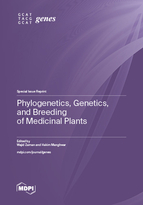Phylogenetics, Genetics, and Breeding of Medicinal Plants
A special issue of Genes (ISSN 2073-4425). This special issue belongs to the section "Plant Genetics and Genomics".
Deadline for manuscript submissions: closed (15 October 2023) | Viewed by 103350
Special Issue Editors
Interests: sustainable catalysis; green chemistry; renewable energy; nanotechnology; biocatalysis; CO2 conversion; biomass valorization; circular economy; machine learning; medicinal plants; climate change mitigation; salinity stress; antioxidants; CRISPR/Cas genome editing
Special Issues, Collections and Topics in MDPI journals
Interests: plant molecular biology; plant stress physiology; plant resistance to different stresses; plant genome editing
Special Issues, Collections and Topics in MDPI journals
Special Issue Information
Dear Colleagues,
Phylogeny represents the historical pattern of relationships among organisms that have arisen in numerous evolutionary events. Breeding has a proven track record of increasing agricultural productivity with a wide range of technologies. In recent years, due to their commercial importance and increasing demand, research on genetics and the breeding of medicinal plants has gradually increased and made some progress. However, much work remains to be done to explore the functions of genes, regulatory mechanisms, and signaling pathways for stimulating the development of breeding technologies in order to improve traits.
Analysis of the adaptive aspects of phylogenetic transformations is important, which can significantly improve the accuracy of phylogenetic reconstructions. Various technologies, including genomics, proteomics, transcriptomics, metabolomics, etc., have been utilized to determine gene functions. These advances have created new opportunities for plant breeding programs to accelerate their genetic gain rates. However, the use of these technologies in the breeding and modification of medicinal plants has been limited, and there is still a lot of room to improve breeding development, detect the biological functions, and identify technological applications in medicinal plants.
Plant breeding has been practiced since the beginning of settled farming. However, its scientific foundation was not firmly established until Mendel’s work on genetics was rediscovered at the end of the nineteenth century. With the advent of new biotechnological possibilities, plant breeding has advanced tremendously over the past three decades. Scientists have made remarkable progress in the fields of breeding, molecular biology, biotechnology genetics, and genomics of medicinal plants. A substantial number of cultivars have been developed through cross-breeding, genomic resources derived from whole-genome sequencing, and the identification of agronomically important traits.
This Special Issue will focus on the advances and prospects for the breeding of medicinal plants. Our goal is to disseminate recent findings and progress on any aspect related to the breeding of medicinal plants. We are looking for original research and review articles and reviews on all relevant topics. This consists of:
- Breeding techniques and methodologies;
- Phylogenetic analysis;
- Plant resistance against biotic and abiotic stresses;
- Development and utilization of genomics technologies;
- Phenotyping technologies;
- Advances in the trait analysis;
- Genetic analysis of traits;
- Gene structure and function analysis.
Dr. Wajid Zaman
Dr. Hakim Manghwar
Guest Editors
Manuscript Submission Information
Manuscripts should be submitted online at www.mdpi.com by registering and logging in to this website. Once you are registered, click here to go to the submission form. Manuscripts can be submitted until the deadline. All submissions that pass pre-check are peer-reviewed. Accepted papers will be published continuously in the journal (as soon as accepted) and will be listed together on the special issue website. Research articles, review articles as well as short communications are invited. For planned papers, a title and short abstract (about 100 words) can be sent to the Editorial Office for announcement on this website.
Submitted manuscripts should not have been published previously, nor be under consideration for publication elsewhere (except conference proceedings papers). All manuscripts are thoroughly refereed through a single-blind peer-review process. A guide for authors and other relevant information for submission of manuscripts is available on the Instructions for Authors page. Genes is an international peer-reviewed open access monthly journal published by MDPI.
Please visit the Instructions for Authors page before submitting a manuscript. The Article Processing Charge (APC) for publication in this open access journal is 2600 CHF (Swiss Francs). Submitted papers should be well formatted and use good English. Authors may use MDPI's English editing service prior to publication or during author revisions.
Keywords
- Medicinal plants
- Breeding techniques
- Phylogeny
- Abiotic stress
- Biotic stress
- Stress physiology
- Molecular mechanisms
- Breeding methodology
- Phenotyping
Benefits of Publishing in a Special Issue
- Ease of navigation: Grouping papers by topic helps scholars navigate broad scope journals more efficiently.
- Greater discoverability: Special Issues support the reach and impact of scientific research. Articles in Special Issues are more discoverable and cited more frequently.
- Expansion of research network: Special Issues facilitate connections among authors, fostering scientific collaborations.
- External promotion: Articles in Special Issues are often promoted through the journal's social media, increasing their visibility.
- Reprint: MDPI Books provides the opportunity to republish successful Special Issues in book format, both online and in print.
Further information on MDPI's Special Issue policies can be found here.








